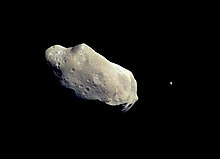Asteroid moon

An asteroid moon is an asteroid that orbits or goes around another asteroid. Asteroid moons are quite rare. Only 2% of asteroids are thought to have moons.
To be an asteroid moon, an asteroid has to be smaller than the object it goes around. If they are roughly the same size they are called a binary pair.
Dimorphos is an asteroid moon that is famous as the target of the Double Asteroid Redirection Test.
References[change | change source]
- Chiang, E.; Lithwick, Y.; Buie, M.; Grundy, W.; Holman, M.; A Brief History of Trans-Neptunian Space, to appear in Protostars and Planets V (August 2006) Final preprint on arXiv

